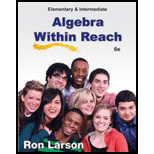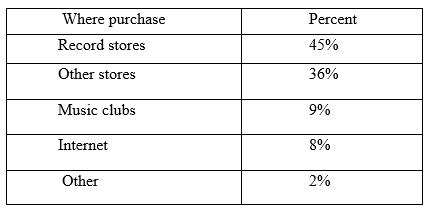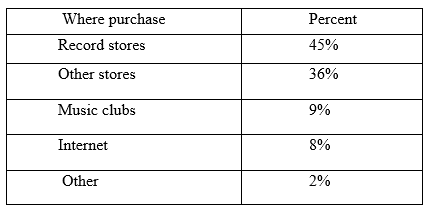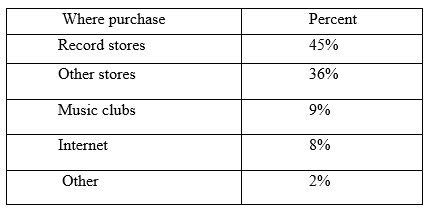
Concept explainers
a.
The number of students who chose either record stores or other stores.
a.
Answer to Problem 57E
The number of students that purchase from either record stores or other stores is
Explanation of Solution
Given:
The given table shows the results of a class survey that asked students where they make most of their music purchases.

Calculation:
As per the given problem
Consider the given table

Total number of students surveyed =
Percent of students that purchase from record stores =
Percent of students that purchase from other stores =
Number of students that purchase from record stores = percent of students that purchase from record stores
Similarly, Number of students that purchase from other stores=percent of students that purchase from other stores
Therefore,
Total number of students that purchase from either record stores or other stores
Conclusion:
The number of students that purchase from either record stores or other stores is
b.
To estimate how many more students chose record stores than music clubs
b.
Answer to Problem 57E
Explanation of Solution
Given:
The given table:

Total number of students surveyed =
Number of students that purchase from record stores =
Calculation:
As per the given problem
Total number of students surveyed =
Number of students that purchase from record stores =
Percent of students that purchase from music clubs =
Number of students that purchase from record stores = percent of students that purchase from music clubs
Difference between the number of students that purchase from record stores and that from music clubs =
Conclusion:
c.
To estimate how many students in both the surveys combined make most of their purchase from internet.
c.
Answer to Problem 57E
Explanation of Solution
Given:
The given table:

Total number of students in the first survey =
Percent of students that purchase from the internet in the first survey =
Number of students surveyed in the second time =
Percent of students that purchase from the internet in the second survey =
Calculation:
As per the given problem
Total number of students in the first survey =
Percent of students that purchase from the internet in the first survey =
Number of students surveyed in the second time =
Percent of students that purchase from the internet in the second survey =
Number of students that purchase from the internetin the first survey = percent of students that purchase from internet
Number of students that purchase from the internet in the secondsurvey = percent of students that purchase from internet
Therefore,
Total number of students in both the surveys combined make most of their purchase from internet
Conclusion:
Chapter 7 Solutions
ELEMENTARY+INTERMEDIATE ALGEBRA
Additional Math Textbook Solutions
Elementary Statistics (13th Edition)
Elementary Statistics: Picturing the World (7th Edition)
A Problem Solving Approach To Mathematics For Elementary School Teachers (13th Edition)
University Calculus: Early Transcendentals (4th Edition)
A First Course in Probability (10th Edition)
- Consider the table of values below. x y 2 64 3 48 4 36 5 27 Fill in the right side of the equation y= with an expression that makes each ordered pari (x,y) in the table a solution to the equation.arrow_forwardsolving for xarrow_forwardConsider the table of values below. x y 2 63 3 70 4 77 5 84 Fill in the right side of the equation y= with an expression that makes each ordered pari (x,y) in the table a solution to the equation.arrow_forward
- There were 426 books sold in one week. The number of biology books sold was 5 times that of the number of psychology books. How many books each were sold?arrow_forwardPopulation decreases 5% each year. Starts with a starting population of 3705. Find that population after 5 years.arrow_forwardsolve using substitution -2x-3y=-15 -3x+9y=12arrow_forward
- Suppose that 7000 is placed in an accout that pays 4% interest. Interest compunds each year. Assume that no withdraws are made. How much would the account have after 1 year? And how much would the account have after 2 years?arrow_forwardUse substitution to solve the equations -2x+5y=18 x=2y-8arrow_forward5) For each function represented by an equation, make a table and plot the corresponding points to sketch the graph of the function. (a) y = 75 ()* 220 X y 200- -2 180 160 -1 140 0 120 100 1 60 80 2 3 4 x (b) y = 20 ()* 1 60 40 20 20 0 2 3 65- -1 X y 60 -2 55- 50 45 44 40 0 35- 30 1 25 2 20 20 15 3 10 5 LO 4 3-2 T -1 0 5- 4- -3- 2-arrow_forward
- A system of inequalities is shown. y 5 3 2 1 X -5 -4 -3 -2 -1 0 1 2 3 4 5 -1- Which system is represented in the graph? Oy>-x²-x+1 y 2x²+3 -2 -3 тarrow_forwardWhich set of systems of equations represents the solution to the graph? -5 -4 -3 -2 Of(x) = x² + 2x + 1 g(x) = x²+1 f(x) = x²+2x+1 g(x) = x²-1 f(x) = −x² + 2x + 1 g(x) = x²+1 f(x) = x² + 2x + 1 g(x) = x²-1 -1 5 y 4 3 2 1 0 -1- -2 -3- -4. -5 1 2 3 4 5arrow_forwardWhich of the graphs below correctly solves for x in the equation -x² - 3x-1=-x-4? о 10 8 (0,2) -10 -8 -6 -2 2 4 6 8 10 (-4,-2) -2 + (0,2) (4,6) -10-8-6-4-2 -2 2 4 6 8 10 (-3, -1) -2 2 (1-5) -6 -8 -10 10 -10-8-6-4-2 2 6 8 10 (2,0)arrow_forward
 Algebra and Trigonometry (6th Edition)AlgebraISBN:9780134463216Author:Robert F. BlitzerPublisher:PEARSON
Algebra and Trigonometry (6th Edition)AlgebraISBN:9780134463216Author:Robert F. BlitzerPublisher:PEARSON Contemporary Abstract AlgebraAlgebraISBN:9781305657960Author:Joseph GallianPublisher:Cengage Learning
Contemporary Abstract AlgebraAlgebraISBN:9781305657960Author:Joseph GallianPublisher:Cengage Learning Linear Algebra: A Modern IntroductionAlgebraISBN:9781285463247Author:David PoolePublisher:Cengage Learning
Linear Algebra: A Modern IntroductionAlgebraISBN:9781285463247Author:David PoolePublisher:Cengage Learning Algebra And Trigonometry (11th Edition)AlgebraISBN:9780135163078Author:Michael SullivanPublisher:PEARSON
Algebra And Trigonometry (11th Edition)AlgebraISBN:9780135163078Author:Michael SullivanPublisher:PEARSON Introduction to Linear Algebra, Fifth EditionAlgebraISBN:9780980232776Author:Gilbert StrangPublisher:Wellesley-Cambridge Press
Introduction to Linear Algebra, Fifth EditionAlgebraISBN:9780980232776Author:Gilbert StrangPublisher:Wellesley-Cambridge Press College Algebra (Collegiate Math)AlgebraISBN:9780077836344Author:Julie Miller, Donna GerkenPublisher:McGraw-Hill Education
College Algebra (Collegiate Math)AlgebraISBN:9780077836344Author:Julie Miller, Donna GerkenPublisher:McGraw-Hill Education





